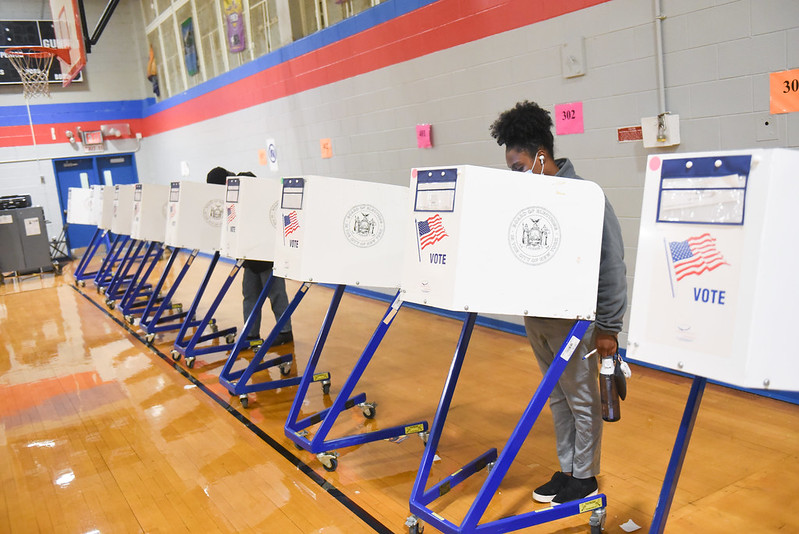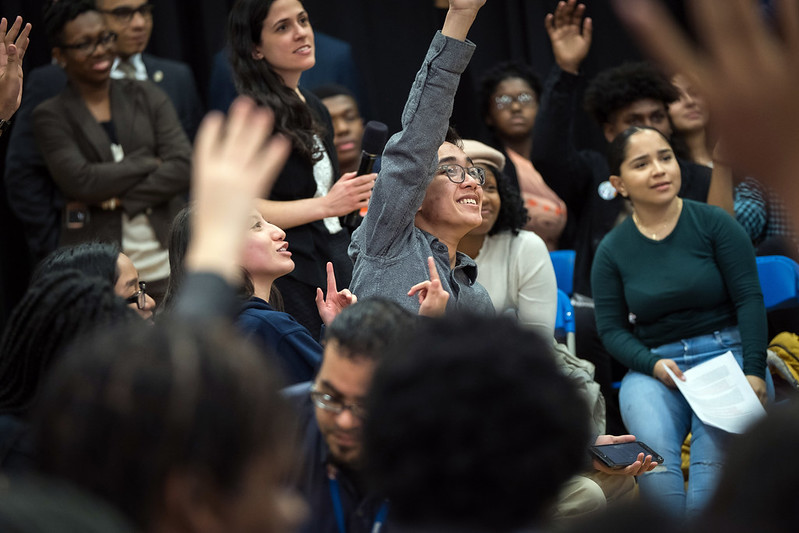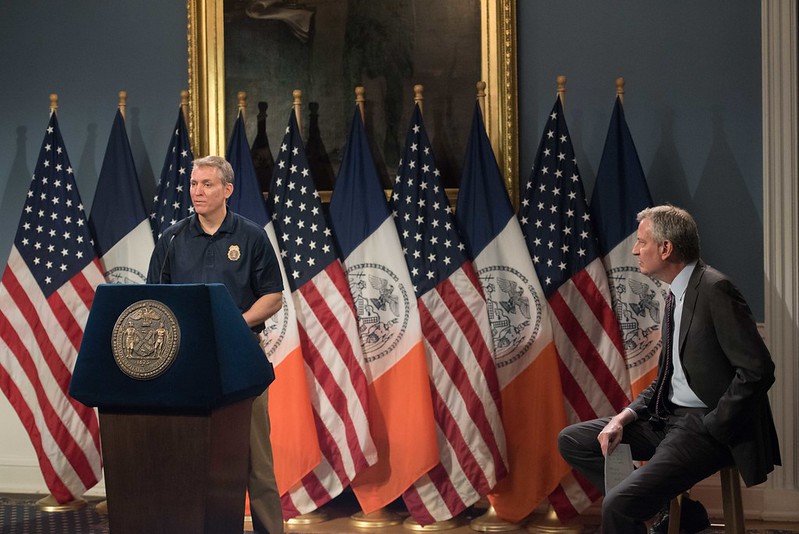Latino Vote '21: A Closer Look at the 2021 Democratic Primary

Voting (photo: Michael Appleton/Mayoral Photography Office)
Four years ago I participated in a forum on the theme of Latino politics and voting participation in New York hosted by the Rev. Ray Rivera of the Latino Pastoral Action Center in the Bronx. The forum was based largely on two columns I had recently written here at Gotham Gazette — “Latinos and the 2017 New York City Elections” and “The Future of Latino Politics in New York City.”
I was the new kid on the block, the “new” Latino political analyst thrust on this panel with two legendary figures: the late Angelo Falcon, the first Puerto Rican political analyst to grace our city, and Juan Cartagena, another pivotal leader and the past head of the renowned LatinoJustice.
I came armed with the most up-to-date political data and the analytical tools gained from years of employing political targeting methods. I came gleeful about the future of Latino politics in New York: Latinos could no longer be taken for granted or ignored. The moment we had predicted decades earlier, of increased Latino electoral participation and increased power, was right around the corner. The sleeping giant had finally awakened.
Falcon, a seasoned observer who had studied Latino voting patterns and trends since I was in elementary school, gently and diplomatically put me in my place. “I am not as optimistic about the future of Latino politics as my colleague Eli,” he said.
Falcon was right.
Looking back at this most recent primary in New York City, the consequential June 2021 elections, armed with more data and perspective, it’s true that:
The primary attracted the second highest Latino voter turnout rate in any primary in New York City.
This was the largest overall Latino voter turnout in a municipal election.
Latinos were a pivotal voting bloc for Eric Adams’ primary victory, with, for example, the Brooklyn borough president garnering close to 50% of the vote in the highest Latino election districts in the Bronx despite the very crowded and competitive field of candidates.
But that’s where the good ends and Falcon’s past skepticism comes in. My projection that Latinos would make up close to a quarter of the Democratic primary electorate fell well short. True, Latinos compose a quarter of all registered Democratic voters (a total of 3,444,859 Democrats) in New York City, but Latinos were only 15% of the roughly 935,294 Democratic voters in that June primary.
In the June 2020 and September 2018 primaries, Latinos made up a little over 20% of the Democratic electorate. These were potential signs of an awakened Latino electorate. But my hopes for this potential came crashing down this year.
More troubling is the fact that only 17% of the 864,511 registered Democratic Latino voters in New York City went to the polls this past June. The Bronx has the highest number of Latino Democratic voters with 283,573 but had the lowest turnout rate, 14%, among Latinos in all the boroughs.
Meanwhile, 20% of Manhattan Latinos went to the polls, the highest among Latinos in all boroughs, and 17% of Brooklyn, Queens, and Staten Island Latinos went to the polls.
Though this incoming City Council class will have the highest number of Latino representatives at 14 of the 51-seat legislative body, Latinos could have potentially won at least two more seats (in districts 25 and 32) had more Latinos voted. Could a higher turnout among Latinos also have kept a Latino helming Borough Hall in the Bronx, the only borough in the city that is majority Latino? Perhaps.
The biggest hindrance for Latino political representation and power in New York City are Latinos themselves.
What can Latino political and community leaders do about this? Let’s begin by taking opportunities like the annual November SOMOS conference in Puerto Rico to strategize how to mobilize Latino voters across the city.
***
Eli Valentin is an adjunct lecturer at Union Theological Seminary. He writes regular columns for Gotham Gazette, largely focused on Latino politics in New York City, and is a frequent guest political analyst at Univision NY. On Twitter @EliValentinNY.
***
Have an op-ed idea or submission for Gotham Gazette? Email This email address is being protected from spambots. You need JavaScript enabled to view it.
The Big, Bold Idea of Smaller Class Sizes

Students (photo: Ed Reed/Mayoral Photography Office)
This week, the City Council heard debate about a bill that would require the New York City Department of Education to cap how many people it can squeeze into our classrooms. The purpose is to ensure better ventilation and reduce the possibility of viral spread — a health safeguard in the era of COVID-19.
The end result would be fewer students in each classroom — a reduction in class size that New York City students, families, and educators have been promised for years.
The DOE doesn’t want to do it. Officials spent the first three hours of the City Council hearing explaining why New York City can’t possibly make this happen.
Brooklyn Council Member Mark Treyger, chair of the education committee and a former high school teacher, noted that the DOE is capable of doing big things — like creating pre-K and 3-K grades — when it wants to.
“Why are we not applying the same big thinking, bold ideas, ambitious energy, towards the issue of class size reduction?” Treyger asked.
Good question!
I have been a teacher in the South Bronx for 18 years. I speak from experience when I say my students receive better instruction when classes are smaller.
Teaching is a profession that requires more than just a quick data touchpoint for success. Understanding your students is more than the answer on a multiple-choice test.
I can think of a time when one of my students came in and clearly wasn't his normal self. It was a small class, so after I finished teaching, it was much easier to take a moment to speak with him one-on-one. It was in that exchange that he shared what was happening to his family, and I was able to get them the individualized support they needed to make sure they had enough food on the table and a safe place to sleep. When that was done, the child could better focus on what was going on in class.
If there had been just one or two more students in the room, I cannot guarantee I would have had the ability to have that conversation. In the end, having a smaller class that year helped more than just my students' academics — it helped a family get the services it needed. This is just one example of how smaller classes allow for individualized attention.
New York City classes are larger than the classes in surrounding communities. According to the National Center for Education Statistics (NCES), the average class size for an elementary school classroom is just 20 students. Yet New York City Department of Education lawyers would cram 28 students in a kindergarten classroom, and up to 32 in grades 1-5.
Middle school and high school classes are more overcrowded. The statewide average for middle school is just 17, while in New York City, our classrooms are packed with up to 33 students. In high schools, statewide the average is 22, while the DOE lawyers would have our students in classes of 34.
And the DOE lawyers and some politicians have proposed even larger class sizes going forward, sometimes claiming there could be as many as 400 students in the same online class using technology.
So why do the districts that are outperforming city schools invest in smaller class sizes? Well, if you have 45-minute periods five days a week with 30 students in the class, you do the math. Fewer students means more individualized attention.
Research across the country has shown that the number of students in a class impacts the quality of education a student receives. Smaller class sizes directly correlate with increased student performance and everyone can have a better school experience.
What DOE officials don’t seem to understand is that our students are more than just test scores and data points. They are more than just an expenditure to be reduced. They are humans who deserve a quality education.
The United Federation of Teachers (UFT) has been the driving force behind reducing class sizes and increasing all students' access to a quality education. In 1964, the union forwent raises in order to get contractual class-size caps. These caps were designed to give each and every student in the New York City public schools the foundation for success. It was an agreement between the city and the UFT with the well-being of students at its heart. Before these class-size caps were in place, classes could balloon to more than 40 children with one teacher.
But we need more. We need the City Council’s proposed legislation, especially in a time when the health and safety of our city’s children rely on the ability to socially distance in a classroom.
This legislation would raise the minimum per person classroom space to 35-square-feet per student from the current 20-square-feet for grades 1–12. Pre-K and kindergarten classes already have a 35-square-foot standard.
Under the new guidelines, the maximum number of students in a 500-square-foot classroom would be 14; in a 750-square-foot room, the total would be 21, bringing the city in line with the levels of safe staffing that the rest of New York State has already recognized.
The DOE would have three school years to implement these changes. The Independent Budget Office estimated that 58% of the city’s schools could implement the change immediately. In other schools, it would obviously take time and an investment in building or leasing additional space. Other tools can also be used.
As Council Member Treyger stressed: the DOE can take on big jobs when it has to.
We need the City Council to pass this legislation. We have waited many years for a series of mayors and schools chancellors to make good on the promise of smaller class sizes. We cannot wait for an administration with a moral compass to do the right thing.
***
Bill Woodruff has been teaching in the South Bronx for 18 years. In addition, he serves as the District 7 Representative for the United Federation of Teachers and is a doctoral student at the University of Pennsylvania.
***
Have an op-ed idea or submission for Gotham Gazette? Email This email address is being protected from spambots. You need JavaScript enabled to view it.
Rewriting the History of 2020 Crime

NYPD Commissioner Shea & Mayor de Blasio (photo: Michael Appleton/Mayoral Photography Office)
We’re seeing history rewritten before our eyes, the heartbreaking death toll of 2020 turned into another political talking point. This time, it’s not COVID-19 fatalities, but the grotesque murders and other violent crimes that impacted so many last year. But while those crimes are all too painfully real, the narrative around this once-in-a-lifetime crime spike is completely fake, and it’s an insult to the memory of those we lost.
Even before this alarmism took center stage at the New York City mayoral debate, we saw it on the front page. When the FBI released its 2020 crime statistics, a cavalcade of alarmist commentators took to the air, peddling police propaganda to explain the murder spike. It’s true that there is a real spike: unprecedented gun sales and record socio-economic instability from COVID-19 pushed murder rates in nearly every city and town up, way up.
But that’s where many commentators go off the rail. It wasn’t just conservative voices like The Wall Street Journal Editorial Board channeling fringe theories that blame the crime increase on Black Lives Matter protesters, but those baseless claims were even published in the The New York Times. In Vox, headlines ran claiming “Murders are spiking. Police should be part of the solution,” while the Washington Post opinion section rejoined, “What’s to blame for the murder spike? Certainly anti-police fervor didn’t help.”
But if you’re hoping for concrete evidence, something proving that the once-in-a-generation revolt against police murders was perversely responsible for a crime spike, you’d be left wanting. There’s nothing, and even though every freshman stats student knows that “correlation doesn’t prove causation,” that simply because events happen at the same time, they aren’t necessarily connected, that’s what the entire argument comes down to.
But the pseudoscience gets even worse. A panoply of police pundits, editorial boards, and city officials have promoted police disinformation, including equally baseless attacks on basic civil rights protections like bail reform. It is not an exaggeration to label this truly disinformation, and it can be deadly. These baseless bail claims have led to a reactionary rejection of pre-trial release for thousands of Americans, forcing thousands to endure appalling and unsanitary conditions in the middle of a pandemic, effectively sentencing some to death for a minor infraction and the ultimate American comorbidity: poverty.
But while we may only recently have received the 2020 data from the FBI, we already have data from individual cities like New York. And here the takeaway is clear: the crime wave crested and receded. Murders were down in August nearly 10% from a year before, and shootings more than 30% lower. But the broader picture is even better.
According to the NYPD, “the number of overall index crimes reported in the city through the end of August is the lowest tally for the first eight months of any calendar year since the start of the modern CompStat era nearly three decades ago.” The Oakland and Chicago Police Departments have both reported a 7% decline in overall crime between 2020 and 2021. The Hartford Police Department reports a 14% decline in overall crime during the same time period. The numbers remain higher than in 2019, as does the lingering impact of the pandemic, but the downward trajectory is clear.
One cannot look at crime data without acknowledging that it is not objective, it is not foolproof, and it certainly isn’t apolitical. Officers and police leadership wield tremendous power to shape our official crime data, and the political narrative that flows from it. Some types of crime, such as homicide, are harder to manipulate, but others can be readily reclassified. With a few edits, a felony burglary is reclassified as misdemeanor trespassing. Simple assault can be classified as armed robbery. And so on.
Whatever the reality of pandemic era policing, we know that the truth may not always show up on paper. But all too often we take FBI data as gospel, as objective, the true federal measure of crime in America. It’s nothing of the sort. And NYPD data can be even more of a political cudgel, with facts selectively collected and reported to support the NYPD’s narrative of the day.
By amassing crime reports from thousands of police agencies across the country, with almost no quality control for what those jurisdictions report, the FBI is able to compile what statisticians would technically call a giant mess. Of course, that data can be valuable, along with records at the state and local levels, but it’s also profoundly flawed. More importantly, the police departments that often offer the initial interpretation of what those statistics mean are truly ill-equipped experts for the tasks. Not only do they have an irresolvable conflict of interest on how crime data is reported, but they frequently don’t have the sociological tools needed to meaningfully address the true drivers of crime.
Since crime data is our main measure of whether the police are doing a “good job,” every officer, precinct commander, and commissioner has incentives to massage the metrics by which they are measured. It’s a tension so well known that it even became a major plot line of the seminal policing show The Wire, as police leaders faced pressure to “Juke The Stats” and change the crime rates reported in their neighborhoods.
Even worse, many departments have zero credibility on this public policy debate. We heard throughout the pandemic that civil rights protections like bail reform were responsible for rising crime, for example when New York City Police Commissioner Dermot Shea wrote a New York Times opinion piece entitled “New York’s New Bail Laws Harm Public Safety,” only to see the claim evaporate when arrest data was examined, and the public could see just how rarely serious crimes were committed by those awaiting trial. Shea recently had to acknowledge his lies at a state legislative hearing.
Last year’s murder rate disrupted years of work; the generational change needed to dismantle mass incarceration. But now that the worst of the crisis is behind us, we can’t let the history of this moment be rewritten. We can’t let the police narrative take center stage. And we can’t treat it as an open question just what drove the recent murder spike. To be as blunt as possible: It was the pandemic, stupid.
***
Albert Fox Cahn is the founder and executive director of the Surveillance Technology Oversight Project (S.T.O.P.), a New York–based civil rights and privacy group, and a visiting fellow at Yale Law School’s Information Society Project. Nina Loshkajian is a D.A.T.A. Law Fellow at S.T.O.P. and a graduate of New York University School of Law. On Twitter @FoxCahn and @ninaloshkajian.
***
Have an op-ed idea or submission for Gotham Gazette? Email This email address is being protected from spambots. You need JavaScript enabled to view it.




